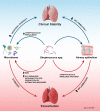The Yin and Yang of Streptococcus Lung Infections in Cystic Fibrosis: a Model for Studying Polymicrobial Interactions
- PMID: 30885933
- PMCID: PMC6509657
- DOI: 10.1128/JB.00115-19
The Yin and Yang of Streptococcus Lung Infections in Cystic Fibrosis: a Model for Studying Polymicrobial Interactions
Abstract
The streptococci are increasingly recognized as a core component of the cystic fibrosis (CF) lung microbiome, yet the role that they play in CF lung disease is unclear. The presence of the Streptococcus milleri group (SMG; also known as the anginosus group streptococci [AGS]) correlates with exacerbation when these microbes are the predominant species in the lung. In contrast, microbiome studies have indicated that an increased relative abundance of streptococci in the lung, including members of the oral microflora, correlates with impacts on lung disease less severe than those caused by other CF-associated microflora, indicating a complex role for this genus in the context of CF. Recent findings suggest that streptococci in the CF lung microenvironment may influence the growth and/or virulence of other CF pathogens, as evidenced by increased virulence factor production by Pseudomonas aeruginosa when grown in coculture with oral streptococci. Conversely, the presence of P. aeruginosa can enhance the growth of streptococci, including members of the SMG, a phenomenon that could be exacerbated by the fact that streptococci are not susceptible to some of the frontline antibiotics used to treat P. aeruginosa infections. Collectively, these studies indicate the necessity for further investigation into the role of streptococci in the CF airway to determine how these microbes, alone or via interactions with other CF-associated pathogens, might influence CF lung disease, for better or for worse. We also propose that the interactions of streptococci with other CF pathogens is an ideal model to study clinically relevant microbial interactions.
Keywords: Streptococcus; Streptococcus milleri group; cystic fibrosis; exacerbation; polymicrobial.
Copyright © 2019 American Society for Microbiology.
Figures

Similar articles
-
Pseudomonas aeruginosa Can Inhibit Growth of Streptococcal Species via Siderophore Production.J Bacteriol. 2019 Mar 26;201(8):e00014-19. doi: 10.1128/JB.00014-19. Print 2019 Apr 15. J Bacteriol. 2019. PMID: 30718303 Free PMC article.
-
Differential potentiation of the virulence of the Pseudomonas aeruginosa cystic fibrosis liverpool epidemic strain by oral commensal Streptococci.J Infect Dis. 2014 Mar 1;209(5):769-80. doi: 10.1093/infdis/jit568. Epub 2013 Oct 24. J Infect Dis. 2014. PMID: 24158959
-
Genotypic and Phenotypic Diversity of Staphylococcus aureus Isolates from Cystic Fibrosis Patient Lung Infections and Their Interactions with Pseudomonas aeruginosa.mBio. 2020 Jun 23;11(3):e00735-20. doi: 10.1128/mBio.00735-20. mBio. 2020. PMID: 32576671 Free PMC article.
-
The Streptococcus milleri group--an unrecognized cause of disease in cystic fibrosis: a case series and literature review.Pediatr Pulmonol. 2008 May;43(5):490-7. doi: 10.1002/ppul.20809. Pediatr Pulmonol. 2008. PMID: 18383109 Review.
-
Pseudomonas aeruginosa biofilms in cystic fibrosis.Future Microbiol. 2010 Nov;5(11):1663-74. doi: 10.2217/fmb.10.125. Future Microbiol. 2010. PMID: 21133688 Review.
Cited by
-
The Microbiome in Cystic Fibrosis Pulmonary Disease.Genes (Basel). 2020 May 11;11(5):536. doi: 10.3390/genes11050536. Genes (Basel). 2020. PMID: 32403302 Free PMC article. Review.
-
Using metabolic potential within the airway microbiome as predictors of clinical state in persons with cystic fibrosis.Front Med (Lausanne). 2023 Jan 9;9:1082125. doi: 10.3389/fmed.2022.1082125. eCollection 2022. Front Med (Lausanne). 2023. PMID: 36698799 Free PMC article.
-
Structure-Function Characterization of Streptococcus intermedius Surface Antigen Pas.J Bacteriol. 2021 Sep 23;203(20):e0017521. doi: 10.1128/JB.00175-21. Epub 2021 Aug 2. J Bacteriol. 2021. PMID: 34339301 Free PMC article.
-
Pseudomonas aeruginosa in the Cystic Fibrosis Lung.Adv Exp Med Biol. 2022;1386:347-369. doi: 10.1007/978-3-031-08491-1_13. Adv Exp Med Biol. 2022. PMID: 36258079
-
Mild Cystic Fibrosis Lung Disease Is Associated with Bacterial Community Stability.Microbiol Spectr. 2021 Sep 3;9(1):e0002921. doi: 10.1128/Spectrum.00029-21. Epub 2021 Jul 7. Microbiol Spectr. 2021. PMID: 34232099 Free PMC article.
References
Publication types
MeSH terms
Substances
Grants and funding
LinkOut - more resources
Full Text Sources
Medical

